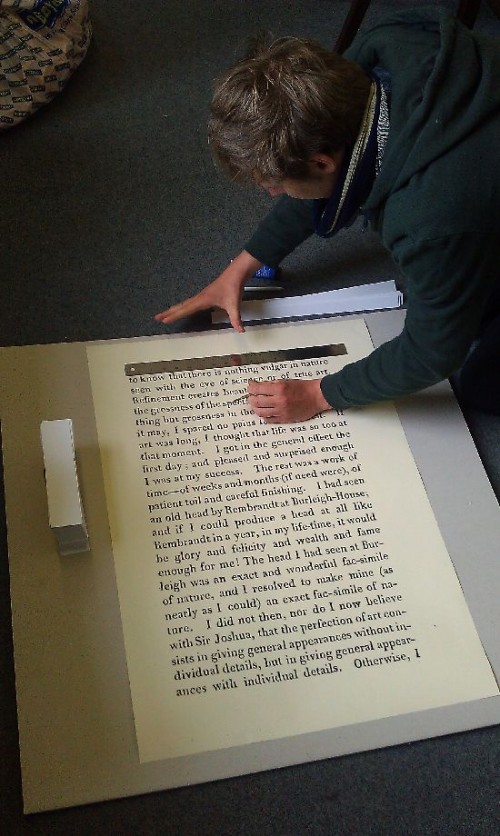
When I see a writer, a word man, among a number of painters, I shake my head. For I know that he would not be there unless he was up to something.
Wyndham Lewis
I’m an unabashed word man. I also enjoy going to visual arts openings but, contrary to what that old Tyro Wyndham Lewis says, it’s rare that I understand the something that I’m meant to be up to. Mostly I just gawp, scratch my bald patch – or other bits if nobody’s watching – and make the most of the free hospitality. Usually I just don’t get it. I experience, as someone recently put it, not so much an exorbitance of misunderstanding as a paucity of comprehension. I doubt the hospitality helps. Still, that’s never stopped me writing about art. The act of stringing words together is simply disconnected from the attempt to make sense of what I’m seeing.
This certainly was the case with the Jaume Plensa exhibition at the Yorkshire Sculpture Park, which I went to see way back in April. I’m not normally quite so tardy with my reviews. Four months is excessive. Something, perhaps, to do with a feeling that the the exhibition was actually just too perfect; comment seemed somehow impertinent. I hate using the word “perfect” – pleasurable seems to weak, entrancing a bit excessive – but what I think I mean is that it was one of those experiences when words seemed insufficient, irrelevant, annoying. It was good to sink into the moment, turn off the chatter in my head and genuinely have nothing to say. What a relief. Recently I have come to the realisation that I only write when there’s a niggle I need to worry at, a knot I have to undo, a scratchiness that won’t let me settle until I’ve got it out of my system. Nothing about the Plensa exhibition made me desperate to rush to cathect at the keyboard.
I wanted to respond somehow though. Just not with words. And I liked the idea of collaborating. Writing can get a bit lonesome, it’s easy to get sunk in a silo of solipsism. I asked Robert (@rasharples) if he fancied working on something together – one of the things I picked up from Jaume’s talk was to get other people to do the donkey work for you, and Robert seemed amenable – and we threw a few ideas around as we explored the exhibition. None of the ideas were any good at first – it was all very stream of consciousness, and the spiggot of thought had been tightening gradually as we indulged in the lavish hospitality of the YSP. The stream became barely an unconscious dribble by the time we left. The idea that seemed to generate the most excitement was to make a plaster cast of my head; this involved wrapping my head in polythene and shoving plastic straws up my nostrils, risking potential second degree skin burns and asphyxiation, apparently . . . the excitement, I concluded, was rather more sadistic than aesthetic. Suffering in the name of art has never been high on my list of things to do before I die – especially if it hastens the actual dying – so I demurred. Couldn’t Robert do something on his computer, I wondered.
A couple of days later, in my office, we were still stumped for an idea. Partly the problem was the vast depth of my artistic incapacity, and partly it was the issue of funding – main issue being, we were skint. So our massive chicken wire head idea, our plan to make a series of substantial Styrofoam crouching figures illuminated from within by eco-friendly, everlasting tea lights, and our intention to create a thirty yard bacofoil poetry screen (that is, a screen of foil with lyrical cut outs, not a screen lauding the delights of aluminium wrap) all proved too much for my meagre talent and our combined purse. We had to work on something more minimal.
As I mentioned earlier, I am a word man. I love the printed page. One throwaway comment that Jaume made, when he was explaining his curtain of text and why he used so many quotes in his work, kept returning to my mind. I couldn’t remember exactly, but it had something to do with “Liberating the words from the page.” This image resonated. What was left behind after Jaume had unhomed the words?
I’d been reading some essays by William Hazlitt earlier in the week. In fact, I probably read a little Hazlitt most days. He is my hero and the writer I most admire . . . no, that’s not right. His writing is what I admire. The words. The man, the writer, was probably insufferable. Anyhow, some of the words from Hazlitt’s essay, “On The Pleasure of Painting” popped into my head. I found a facsimile of the original 1821 edition online – it had to be that edition for all sorts of aesthetic reasons, primarily the size of the words and their position on the page – later editions cram many more words into a smaller space and reduce the white space around the text. I emailed Robert . . . The rest of the story is all down to him. He did all the real work.
Robert had the page printed in A1. He painstakingly sliced each individual word off the page. Then he took every word, all 246, and stuck them on individual pieces of card, making some rather attractive bookmarks. Then we hung the voided page up in front of a light and took some pictures. I’m not sure this is art – though, if anyone wants, I could come up with some cleverly incomprehensible chunk of art speak to justify its existence – and I’m not sure what YSP and Jaume Plensa feel about it. Though as I’m writing this, Robert is delivering the work to the shop in Bretton Hall.
So, I suppose there’s nothing much more to say. Except, if anyone fancies a very limited edition bookmark get in touch with me or Robert. Or get down to the Yorkshire Sculpture Park and pick one up. The Jaume Plensa Exhibition is on until the 25 September.
Yorkshire Sculpture Park
West Bretton
Wakefield WF4 4LG
01924 832631
info@ysp.co.uk
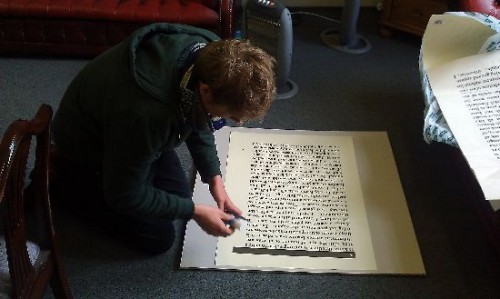
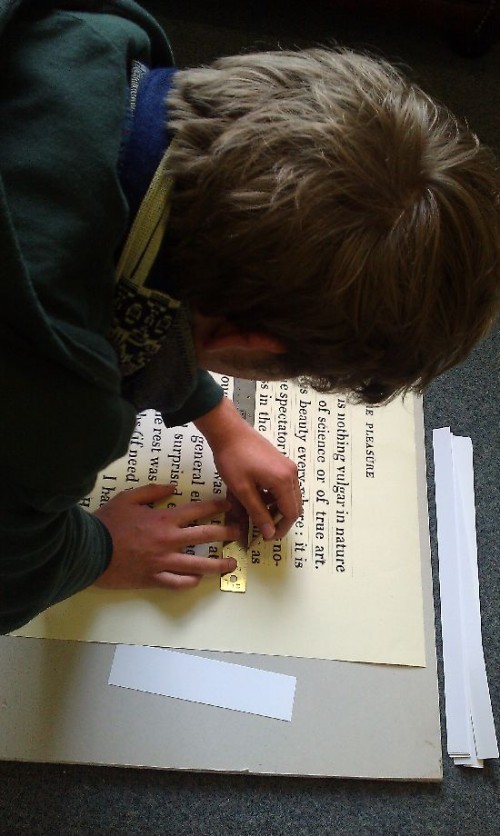
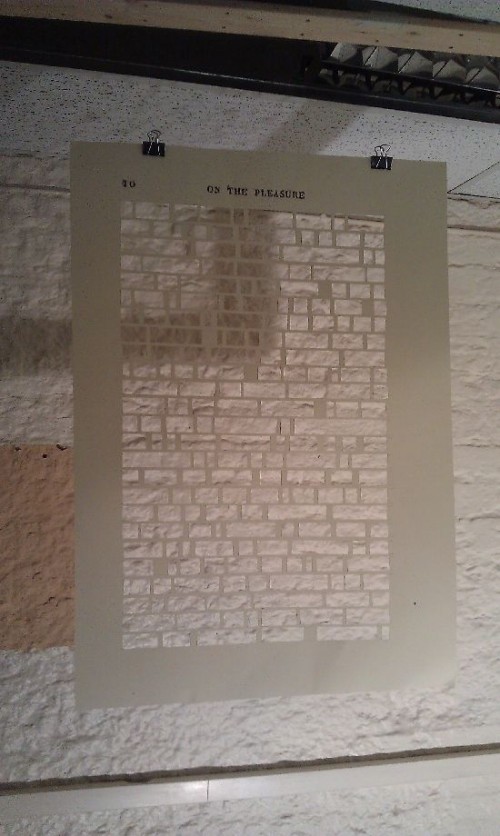
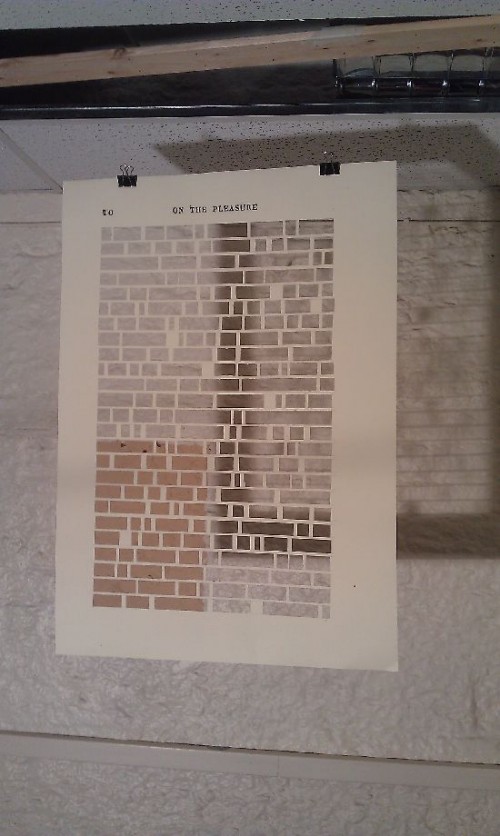
Now that’s what I call, redacted!
Lovely word, but I’m not sure it’s accurate. Dismantled is more like it.